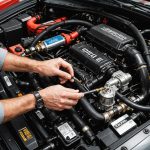Understanding Carbon Emissions from Vehicles
Carbon emissions from vehicles are a major contributor to environmental concerns worldwide. Every time a car engine burns fuel, it releases vehicle emissions comprising carbon dioxide (CO2) and other harmful pollutants. With millions of cars on the road, these emissions significantly impact the planet’s health by contributing to climate change and poor air quality.
Reducing these emissions is crucial for achieving environmental sustainability. Lowering the amount of CO2 released into the atmosphere can help mitigate climate change, leading to fewer extreme weather events and healthier ecosystems. To accomplish this, society needs to adopt cleaner technologies and more efficient transportation modes.
Additional reading : A Comprehensive Guide to Securing Your Blue Badge for Disabled Parking in the UK
In the UK, the statistics demonstrate the urgency of addressing this issue. In 2022, cars emitted an estimated 68 million tonnes of CO2, accounting for nearly 19% of the nation’s total carbon emissions. These figures underscore the need for immediate action to curb emissions through policies and practices promoting sustainable alternatives. Long-term benefits include improved air quality and a reduced carbon footprint, heralding a greener future for everyone.
Strategy 1: Adopt Eco-Friendly Driving Habits
Embracing eco-friendly driving practices is pivotal for reducing fuel consumption and lowering carbon emissions. Driving techniques like maintaining a consistent speed and avoiding rapid acceleration can significantly enhance fuel efficiency. These green driving tips not only help save money at the pump but also contribute to a cleaner environment.
Topic to read : Your Ultimate Guide to Selecting the Perfect Roadside Assistance Plan in the UK
When you accelerate rapidly, your vehicle consumes more fuel and consequently produces higher carbon emissions. By accelerating smoothly and driving at optimal speeds, you can reduce your vehicle’s fuel consumption. The goal is to keep the engine operating efficiently, which decreases the amount of fuel burned and emissions produced.
Additionally, maintaining a steady speed using cruise control when appropriate can prevent unnecessary fuel wastage. On highways, vehicles demonstrate higher efficiency at moderate speeds compared to extreme lows or highs. This efficient fuel use leads to less frequent refueling, ultimately promoting eco-friendliness.
It’s crucial to regularly check and maintain your vehicle’s tire pressure, engine condition, and alignment. These factors also influence fuel efficiency and overall environmental impact. By adopting these practices, drivers can play a key role in supporting environmental sustainability while enjoying cost savings.
Strategy 2: Regular Vehicle Maintenance
Regular vehicle maintenance is crucial for ensuring vehicles operate efficiently and produce lower emissions. It starts with consistent car servicing, which directly impacts a car’s emissions. Comprehensive services go beyond basic oil changes, including vital systems like exhausts, brakes, and air filters, all of which contribute to emissions reduction.
Monitoring and maintaining correct tire pressure is another essential practice. Properly inflated tires not only enhance fuel efficiency but also reduce the vehicle’s overall carbon footprint. Appropriate oil changes at recommended intervals help maintain engine performance and prevent the build-up of harmful deposits, further aiding in emissions reduction.
Recognising the optimal time to replace parts is fundamental. Replacing worn-out components, like oxygen sensors or catalytic converters, at the right time enhances fuel efficiency and significantly decreases harmful exhaust emissions. Ignoring these replacements can lead to increased pollutants escaping into the atmosphere.
In addition to emissions reduction, these maintenance practices can prolong the vehicle’s lifespan and improve its overall performance. A well-maintained car should achieve optimal efficiency, benefitting both the environment and the owner’s wallet by reducing fuel consumption and minimizing future repair costs.
Strategy 3: Choose Fuel-Efficient Vehicles
Selecting fuel-efficient cars is a strategic move towards sustainability. These vehicles, including hybrid and electric models, offer significant benefits by producing fewer emissions and reducing fuel consumption.
- Benefits: Opting for low-emission vehicles not only decreases your carbon footprint but also leads to cost savings on fuel. Hybrids combine conventional engines with electric power to enhance fuel efficiency, while electric vehicles (EVs) utilise alternative energy, negating the need for petrol altogether.
Understanding the UK market is essential for prospective buyers. The availability of fuel-efficient options is expanding, supported by government incentives such as grants and reduced taxation. These factors make transitioning to eco-friendly vehicles more accessible.
The choice of vehicle has a profound impact on carbon emissions. With the transportation sector being a major contributor to greenhouse gases, selecting a low-emission model can substantially lower your personal environmental impact.
When considering your next vehicle, prioritising efficiency and emissions can foster a more sustainable lifestyle. Choose wisely to join the movement towards a greener future, ensuring benefits both for your wallet and the planet.
Strategy 4: Optimize Your Driving Route
Navigating efficiently involves more than simply reaching your destination. It’s about ensuring fuel efficiency and minimizing emissions along the way. Thanks to GPS driving technology, optimization becomes simpler and smarter.
Firstly, modern GPS technology offers route optimization that considers multiple critical factors such as traffic conditions and road types. It’s not just about finding the shortest distance but identifying the quickest and most fuel-efficient way. These navigation systems adjust your route in real-time to steer clear of congested roads where idling in traffic can significantly increase emissions and fuel use.
Understanding your travel patterns helps too. Stop-and-go traffic, particularly prevalent in urban areas, can lead to higher emissions due to frequent acceleration and braking. This not only wastes fuel but also contributes to higher carbon footprints.
To save fuel while driving, consider the following strategies:
- Use GPS to avoid rush hours and busy intersections.
- Preferance highways over inner-city roads.
- Keep abreast of traffic alerts and suggested alternative routes.
By leveraging the precision of GPS driving and focusing on strategic route optimization, you’ll find yourself saving time, money, and the environment effortlessly.
Strategy 5: Use Public Transport Alternatives
Embracing public transport provides a practical method to significantly reduce one’s personal carbon footprint. Transitioning from driving personal vehicles to using buses, trains, or trams minimizes individual emissions considerably. Public transport systems are designed to efficiently move large numbers of passengers using fewer resources per capita, which leads to reduced greenhouse gas emissions.
In addition to public transport, carpooling practices further enhance sustainability. By sharing rides, individuals collectively lower the number of vehicles on the road, contributing to decreased emissions and fuel consumption. Carpooling can be an excellent solution for communities, workgroups, and schools, fostering a shared commitment to eco-friendly travel.
Exploring local transport options is especially relevant in the UK, where many cities offer diverse and reliable public transit choices. Integrating buses, underground networks, and even bicycles into daily routines can revolutionize urban commuting. Emphasizing sustainable travel not only supports environmental goals but also results in cost savings and reduced traffic congestion.
Encouraging behaviors towards sustainable travel benefits both the environment and individuals, as clean public transport options become more accessible and cost-effective. Choose wisely and travel sustainably.
Strategy 6: Reduce Weight in Your Vehicle
Reducing the weight of your vehicle is a practical way to enhance fuel economy and contribute to carbon emissions reduction. It’s simple; heavier vehicles demand more energy to move, resulting in increased fuel consumption. Therefore, keeping your vehicle as light as possible directly improves efficiency.
Decluttering your vehicle is an effective starting point. Regularly check your car for items that don’t need to be there. It might be tempting to use your car as a storage space, but removing non-essential items can make a noticeable difference. Consider removing extraneous gear from the boot or passenger compartments, which simply adds unnecessary weight.
Minimizing unnecessary load on trips is also beneficial. Avoid carrying heavy objects unless essential, as each kilogram impacts the car’s performance. Be mindful of roof racks and bike carriers when they’re not in use. These can contribute significantly to drag, affecting not just weight but also aerodynamics.
By implementing these steps, you align more closely with sustainable practices. Saving on fuel costs is an incentive, but the broader benefit is contributing to a healthier planet through reduced emissions. Embrace these strategies for smarter, more efficient driving endeavours.
Strategy 7: Limit Idling Time
Idling engines contribute significantly to unnecessary emissions and fuel wastage. Every minute an engine remains running without moving the vehicle, it releases pollutants into the air, impacting both the environment and human health. This progressively eats away at fuel reserves, costing money and adding wear to the engine.
To tackle this, turning off the engine when parked or when waiting for a few minutes is a simple but effective measure. Modern vehicles start faster and more efficiently, making it less critical to keep the engine running compared to older models.
Certain situations are particularly notorious for causing excessive idling. For example, waiting in long queues at drive-thrus, stuck in heavy traffic, or when warming up the car on a chilly morning. Shutting the engine off during these times can contribute to better emissions control and result in significant fuel savings over time, reducing both environmental impact and personal expenses.
By conscientiously adopting these practices, drivers can make a positive difference. This proactivity ensures both immediate and future benefits, enhancing environmental responsibility and economic efficiency.
Strategy 8: Consider Alternative Fuels
In the UK, alternative fuels such as biofuels and hydrogen are gaining traction as viable complements to traditional energy sources. Both biofuels and hydrogen represent renewable energy options, aiming to reduce reliance on fossil fuels and decrease carbon emissions.
Biofuels, derived from organic materials like plants and algae, can seamlessly integrate with existing fuel systems. They offer a more sustainable option that requires minimal retrofitting of engines. Hydrogen fuel, on the other hand, although less commonly used, presents tremendous potential due to its efficiency and the absence of harmful emissions. This clean alternative fuel can power vehicles and industrial processes without producing greenhouse gases, therefore lowering the ecological footprint.
Despite the benefits, transitioning to these sustainable options faces significant hurdles. Current infrastructure challenges include the need for more hydrogen filling stations and facilities to process and distribute biofuels effectively. Enhancing these infrastructures is crucial to support widespread adoption and ensure these renewable energy sources are accessible to all. Progress is being made, as both government and private sectors invest heavily in developing necessary technologies and networks to make the switch to alternative fuels seamless and more practical.
Strategy 9: Utilize Technology for Emission Tracking
In today’s technologically advanced world, leveraging mobile apps for emission tracking is more accessible than ever. Eco-driving apps are designed to monitor your fuel economy and emissions effectively. These applications analyse driving habits, offering real-time feedback to help users adopt more environmentally-friendly behaviour. By providing data on fuel efficiency and emissions, these apps empower individuals to understand their impact on the environment.
Telematics plays a crucial role in enhancing driving behaviours. By collecting and transmitting data about vehicle use, telematics systems offer insights into driving habits that can lead to better decision-making. For instance, they can identify aggressive driving patterns, such as sudden acceleration or excessive speed, that negatively impact fuel economy. Addressing these habits can not only improve efficiency but also lower emissions.
Setting personal carbon reduction goals becomes more manageable with the help of technology. By using these apps, drivers can set targets for decreasing their environmental footprint. The technology assists in tracking progress, making it easier to stay committed to these goals. Adopting such tools helps individuals actively contribute to a more sustainable future, one journey at a time.
Strategy 10: Engage in Community Initiatives
Community engagement plays a vital role in promoting sustainable driving habits. By participating in local sustainability efforts, UK drivers can significantly contribute to carbon reduction and improve their ecological footprint.
One fruitful opportunity is joining local carbon reduction programs. These initiatives often involve activities such as carpooling groups, community electric vehicle (EV) charging stations, or participating in tree-planting events. Engaging in such programs not only helps in reducing personal emissions but also supports broader environmental objectives within the community.
Collective efforts multiply the impact on emissions reduction. When communities collaborate, they can achieve results that far exceed what individuals might do alone. For instance, a neighborhood initiative to encourage electric vehicle adoption can lead to a significant decrease in fossil fuel reliance, diminishing collective emissions.
Moreover, being part of community efforts fosters a sustainable mindset. Regular interaction with like-minded individuals can share knowledge, inspire change, and support one another in the journey towards eco-friendly practices. As a result, participation in community initiatives can create lasting behavioural shifts towards sustainable driving.











